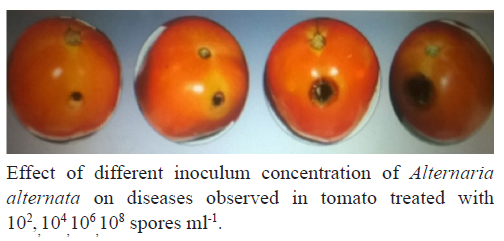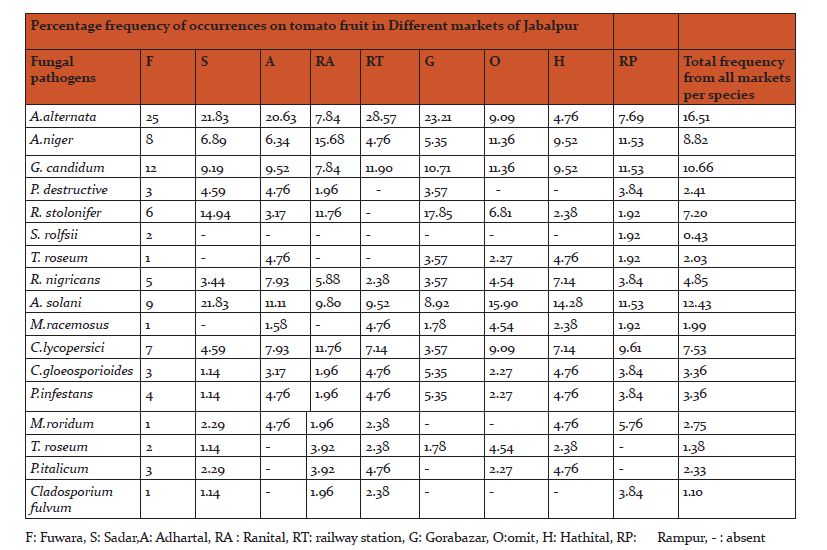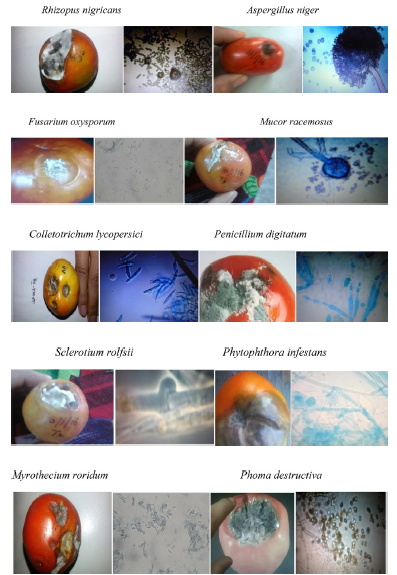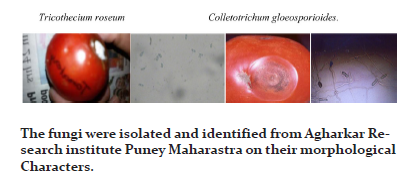IJCRR - 9(5), March, 2017
Pages: 12-16
Date of Publication: 20-Mar-2017
Print Article
Download XML Download PDF
Fungi Associated with the Spoilage of Post Harvest Tomato Fruits and Their Frequency of Occurences in Different Markets of Jabalpur, Madhya-Pradesh, India
Author: Sajad A. M.1, Jamaluddin2, Abid H.Q.3
Category: General Sciences
Abstract:During the regular survey of local Tomato growing field of Jabalpur, it was observed that most of the Tomato fruits have been suffered by fruit rot disease caused by Alternaria alternata, Aspergillus niger, Geotrichum candidum, Alternaria solani, Mucor racemosus, Aspergillus flavus, Fusarium oxysporum, Fusarium moniliforme, Penicillium digitatum,Rhizopus stolonifer, alternaria alternata,Colletotrichum lycopersici, Sclerotium rolfsii, Myrothecium roridum, Phoma destructiva and Trichothecium roseum. Highest frequency of occurrences occurred in Alternaria alternata 16.51%, followed by Alternaria solani 12.43%, Geotrichum candidum 10.66%, Aspergillus niger 8.82%, Colletotrichum lycoperssici 7.53%. Lowest frequency of occurrences were found in sclerotium rolfsii, Mucor racemosus, Penicillium italicum and Cladosporium fulvum. Percentage frequency of occurrences on all tomato fruits were found maximum for Alternaria alternata I6.51%. Therefore Alternaria alternata were selected for test organism for pathogencity test.
Keywords: Fungal pathogens, Lycopersicon esculentum fruit, Different markets of Jabalpur, Percentage frequency of occurrences
Full Text:
Introduction
Tomato fruit is used worldwide, eaten as both raw and processed forms (Moneruzzaman et al., 2008). It is annual and short lived perennial herb, dicotic and angiospermic plant belongs to family solanaceae. It was first reported from South America and entered to Europe in 16th century, later to East Africa in the early 1900 (Wamache, 2005). Tomato is rich in vitamins, Carbohydrates, proteins, fats and potassium (Talvas et al., 2010). Post harvest handling, weak storage practices, transportation and improper marketing are seriously affecting the quality of tomatoes. Tomato fruit rots are mainly caused by fungi Several fungal species were associated to cause fungal infections in tomatoes. They were Geotrichum candidum, Rhizopus stolonifer, black mold rot caused by Alternaria sp., Fusarium rot by Fusarium sp. Tomato contaminated with Fusarium species is dangerous for human health, because they produce mycotoxins (Burgess 1985, Jofee 1986, Nelson et al., 1990). Magnitude of post harvest losses in fresh tomato fruits is to be estimated 25.80% (Thirupathi et al., 2006). It is difficult to harvest tomatoes without causing any damage. Fungal rots on tomatoes are not only problem in Indi but is a worldwide problem. Alternaria rot has been considered a common diseases and causes huge losses to tomatoes thus making tomatoes unfit for consumption (Douglas 1922). Sour rot of tomatoes due to Geotrichum candidum is a wound pathogen gets easy chance to enter in injured portion (Brown 1979, Carmo-Sousa 1965, Gutter 1978, Lewis and Sinclair 1966, Mahmood 1970 and Moris 1982). The magnitude of post-harvest losses always vary from one country to another country and one season to another and even one day to another (Mujib et al., 2007). Control of tomato rots always remain challenge for researchers.
Huge losses has forced to researchers for simple effective and economic methods to control post harvest diseases and other losses in tomatoes (Wilson and Wisniewski 1989). Post harvest practices include harvesting, storage, processing, packaging, transportation and marketing (Merema and Rolle, 2002). These post harvest losses are more severe in developing than developed nations (Enyiukwu, 2014). It is estimated that ripe tomato fruit contain approximately 94 % of water, 4.3 % carbohydrates, 1 % protein, 0.1 % fat, 0.6 % fibre and vitamins. Both the biological and physical damages during the harvest and transportation phases, coupled with large amount of water and soft endocarp makes tomatoes more susceptible to spoilage by fungi (Asan and Ekmeki, 2002, Onuoral and Orji, 2015).
Materials and methods:
Collection of Tomato fruits.
Different infected tomato fruits and few fresh tomato fruits were collected from nine different sites of Jabalpur Madhya Pradesh. Samples were collected in sterilised polythene bag.
Mycological studies
For isolation of fungal pathogens from diseased part of tomato fruit, first we need preliminary operation for isolation including, sterilisation of glassware’s, petriplates and other materials needed. These petriplates and conical flasks were and slides were properly washed in chromic acid solution and then sterilized in hot air oven at 1600C for one hour. Sterlized petriplates were used for PDA medium and were put in petriplates in appropriate concentration.
Isolation of associated fungi
Infected samples were first washed with running tap water. An appropriate size of spoilt tomatoes were carefully cut with the aid of sterile blade then sterilized with 70% ethanol and rinsed in sterile distilled water. Sliced portion were then plated on sterile PDA medium and 2% tetracycline was used to inhibit bacterial growth and then incubated at 26+1C0. Incubation was carried out in inverted positions of petriplates for 4-6 days. The colonies thus developed are repeatedly sub cultured on PDA medium to obtain pure cultures. Isolations were identified based on cultural and microscopic characteristics and compared with standard mycological texts. (Donsch et al., 1980, Burnett and Hunter 1992). Unidentified fungal species were identified from Agharkar Research Institute Puney, Maharastra.
Identification of Fungi
The wet mount of isolates, lactophenol in cotton blue were examined in digital microscope and identified based on their morphology, mycelia structure, Conidial structure and arrangement.
Pathogenicity test
Pathogenicity test showed severe decay of tomato fruit inoculated with their respective pathogens under laboratory conditions. On infected portion, fungal growth was clearly visible. These symptoms resemble to those found under natural conditions. Fruit inoculated with distilled water remains does not show any sign of infection. Initial symptoms were observed after three days of inoculation. Small light brown spots which increase in size. Fungal mycelium on PDA appears as dark greenish colonies

Results
The results obtained from this study have indicated that tomatoes which are marketed in different markets of Jabalpur are contaminated by fungal pathogens. Isolates such as Aspergillus niger, Alternaria solani, Aspergillus flavus, Mucor racemosus, Geotrichum candidum, Phoma destructiva, Sclerotium rolfsii, Trichothecium roseum, Colletotrichum lycopersici, Rhizopus nigricans and Colletotrichm spp., etc. This is in agreement with the findings of Kutama et al., 2007. Who also reported several fungal pathogens associated with the tomatoes. Alternaria alternata were prevalent among all isolates. The result of pathogenicity test by Alternaria alternata showed that fungal isolates were capable of causing diseases if proper conditions were given. Temperature and Humidity are important factor, which affect the vegetable fruits and provides medium for the growth of fungal pathogens.
In Alternaria alternata, it was observed that concentration of spores/ conidia increased the severity of diseases. At low concentration 102 spores ml-1. The lesion diameter was 9.6mm where as at high concentration 108 spores ml-1 it was 22.23 mm respectively.


 Tomato were found to be infected with A. alternata, Aspergillus niger, Geotrichum candidum, Phoma destructiva, Rhizopus stolonifer, Trichothecium roseum, Alternaria solani, Colletotrichum lycopersici, Rhizopus nigricans and Mucor racemosus throughout the year (2013-2016). However Cladosporium fulvum, Sclerotium rolfsii, Myrothecium roridum and Penicillium italicum were not frequent. Highest frequency of occurrences occurred in Alternaria alternata 16.51%, followed by Alternaria solani 12.43%, Geotrichum candidum 10.66%, Aspergillus niger 8.82%, Colletotrichum lycopersici 7.53%. Lowest frequency of occurrences occurred in sclerotium rolfsii, Mucor racemosus , Penicillium italicum and Cladosporium fulvum. Percentage frequency of occurrences on all tomato fruits were found maximum for Alternaria alternata I6.51%.
Tomato were found to be infected with A. alternata, Aspergillus niger, Geotrichum candidum, Phoma destructiva, Rhizopus stolonifer, Trichothecium roseum, Alternaria solani, Colletotrichum lycopersici, Rhizopus nigricans and Mucor racemosus throughout the year (2013-2016). However Cladosporium fulvum, Sclerotium rolfsii, Myrothecium roridum and Penicillium italicum were not frequent. Highest frequency of occurrences occurred in Alternaria alternata 16.51%, followed by Alternaria solani 12.43%, Geotrichum candidum 10.66%, Aspergillus niger 8.82%, Colletotrichum lycopersici 7.53%. Lowest frequency of occurrences occurred in sclerotium rolfsii, Mucor racemosus , Penicillium italicum and Cladosporium fulvum. Percentage frequency of occurrences on all tomato fruits were found maximum for Alternaria alternata I6.51%.



Discussions
During my survey (2013-2016) of local markets of Jabalpur. Tomato was seen as most important vegetable crop of Jabalpur, not only in Jabalpur but all over India. However, in comparison to many other countries, its production in India is hampered due to diseases in the markets and fields, which causes huge losses. Alternaria solani were already reported by Agarwal et al., 1950 in local markets of Jabalpur. Kajansoon and Mathur, 1961 also reported it on tomato fruit. Alternaria solani were also reported from Tikamgarh MP india by Chaurasia et al., 2013. Fungal rot by Alternaria solani were also reported by Hasssan, 1996 from different parts of India. Aspergillus niger also causes black mold, and causes huge losses to tomato fruits in Jabalpur market. Anwer et al., 2013 also reported Aspergillus niger on tomato fruit. Fusarium oxysporum mostly reported in wet conditions reported already by Ansari et al., 2012. Sclerotium rolfsii forms yellowish lesions and on tomato fruit, Banyal et al., 2008 . Phytophthora infestans were also reported from Jabalpur market and other parts of India. Trichothecium roseum form 2 celled conidia on tomato fruit which is characteristic feature of it. A. alternata were the pathogens which were responsible for heavy losses in tomato and other vegetable fruit commodity during survey conducted in the local markets of Jabalpur. The results of regular market survey revealed that most of the tomato fruits have been suffered by fruit rot disease by Alternaria solani, Rhizopus rot caused by Rhizopus stolonifer, buckeye rot caused by Phytophthora species, black mold rot caused by Alternaria alternata and Fusarium rots caused by Fusarium species. Diseases constitute a serious limiting factor to tomato production in Jabalpur, M.P. Thus, it can be suggested that the intake of spoilt tomatoes could be dangerous, since these organisms produce spores and toxins that could cause severe food poisoning that will result in fatal outcome. It is not only necessary to improve the average production of this crop, but also to protect the produce from postharvest losses due to infection.
Conclusion
Many studies were carried out with respect to occurrences, causal organisms, severity, losses and pathogenicity. The present study showed that many fungal pathogens are associated with tomato diseases. In present investigation, Aspergillus niger, A. flavus, Alternaria, Penicillium, Rhizopus sp, are found to be major disease causing organisms. Tomato fruits were more prone to infection by fungal pathogens than bacteria and viruses. Alternaria alternata appeared to be most active of all the pathogens that result losses of economic resources as well as mycotoxins. Control measures must be employed by vegetable growers, marketers and consumers at the time of harvesting, transportation, handling, storage and processing of tomato fruits.
Acknowledgement
We acknowledge the immense help, received from the scholars whose articles are cited and included in references of this manuscript. We are also grateful to authors, editors, publishers of all those articles and journals and books from where the literature of this article have been reviewed and discussed.
References:
Brown, G.E. 1979. Biology and control of Geotrichum candidum. The cause of citrus sour rot. Fla state Hortic. Soc. 92: 186-189.
Burgess, L.W., Nelson, P.E., Tousson, T.A. & Marasas, W.F.o. 1985. Fusarium scirpi: Amended description and notes on geographic distribution. Mycologia 77: 212-218
Douglas B, 1922. A new Alternaria spot of tomatoes in California. Phytopathology, 12: 146-148.
Gutter, Y. 1978. A new method for inoculating citrus fruit with Geotrichum candidum phytopathol, Z. 91: 359-361.
Joffe, A.Z. 1986. Fusarium Species: Their Biology and Toxicology. New York: John Wiley and Sons.
Kutama, A.S., Aliyu, B.S., Muhammed I. 2007. Fungal pathogens associated with tomato wicker storage baskets. Science world journal, 2:345-378
Lewis, M.H. and Sinclair, J.B. 1966. Geotrichum candidum. Plant tissue Ph. and susceptibility to plant and animal isolates. Plant Dis. Rep. 54: 681-685
Moneruzzaman K.M. Hossain A. Sani W. and Saifuddin, M. (2008). Effect of stages of maturity and ripening conditions on the biochemical characteristics of tomato. American Journal of Biochemistry and Biotechnology. 4: 336-344.
Moris, S.C. (1982). Synergism of Geotrichum candidum and Penicillum digitatum in infected citrus phytopathology, 72: 1336-1339.
Mujib, U. R., Naushad, K. and Inayatullah, J. 2007. Post-harvest losses of tomato crop. Sarhad Journal of Agriculture, 23(4): 1279
Kajansoon, P. and Mathur, R.S. 1961. Fungus flora of stored vegetables and pulse seeds its relation to premergence injuries and the beneficial effect of fungicidal seed treatments, Proc.Nat.Acad.Sci.India31:416-421.
Chaurasia, A.K., Chaurasia,S., Chaurasia,S. and Chaurasia Su., (2013) Studies on the development of fruit rot of tomato caused by Alternaria solani. International Journal of Pharmacy and sciences, 4(6).
Hassan H.A.H., (1996). Alternaria mycotoxins in Black rot lesion of tomato fruits: Conditions and regulations of their productions. Acta Immunolgica Hungarica, 43, 125-133.
Anwer, A. and Khan, M.R., (2013). Aspergillus niger as tomato fruit, quality enhancer and plant health promoter, Journal of post harvest technology 1(1)36-51.
Ansari, S., Shahab, S., Mazid, M., Ahmed, D. (2012). Comparative study of Fusarium oxysporum f sp. lycopersici and Meloidogyne incognita race-2 on plant growth parameters of tomato. 3(6): 844-847
Banyal, D.K. Mankotia, V. Sugha, S.K., 2008, Integrated management of tomato collar rot caused by Sclerotium rolfsii. J.Mycol. Plant pathol., 38:165-167.
Nelson, P.E., Burgess, L.W. & Summerell, B.A. 1990. Some morphological and physiological characters of Fusarium species in sections liseola and elegans and similar new species. Mycologia 82: 99-106
Agarwal G.P., Neme K.G., Beliram R., 1950. Fungi causing plant disease at Jabalpur, M.P. Proc. Nat. Acad. Sci. India. 13: 310-315.
Talvas, J, Caris-veyrat, C, Guy L, Rambeau, M, Lyan B., Minet-Quinard, Lobaccaro, J.A, Vasson, M., George, S., and Mazur A. (2010). Differential effects of lycopene consumed in tomato paste and lycopene in the form of purified extract on target genes of cancer prostatic cells. American Journal of Clinical nutrition, 91: 1716-1724.
Thirupathi, V. Sasikala, S. and John Kennedy, Z. (2006). Preservation of fruits and vegetables by wax coating, pp1-10. In: Science Technology Enterpreeur. (Mittal, H.K. et al) (eds) NSTEDS, DST. Delhi.
Wilson, C.L. and Wisniewski, M.E. (1989). Biological control of postharvest diseases of fruits and vegetables: an emerging technology. Annu. Rev. phytopathol. 27: 425-441.
Merema, C.G., Rolle, S.R. (2002). Status of the post harvest sector and its contribution to agricultural development and economic growth. 9th JIRCAS International symposium- Value Addition to Agricultural product, pp.13-20.
Enyiukwu D.N., Awurum, A.N., Nwaneri, J.A. (2014). Efficacy of plant derived pesticides in the control of myco-induced post harvest rots of tubers and agricultural products: Net Journal of Agricultutral science 2(1): 30-45.
Asan, A. and Ekmeki, S. (2002). Contribution to the colonial and morphological characteristics of some Aspergillus species isolated from soil. Journal of Faculty of Science 25:121-139
Onuorah, S. and Orji, M.U. (2015). Fungi Associated with the Spoilage of Post-harvest Tomato Fruits Sold in Major Markets in Awka, Nigeria. Universal Journal of Microbiology Research 3(2): 11-16
Domsch, K.H.,Gams, W. and Anderson, T.H. (1980). Compendium of soil fungi. Vol, Academic press, London, 859pp.
Barnett, H.L. and Hunter, B.(1972). Illustrated genra of imperfect fungi. Burgress publishing companyMinneapolis 241pp.
Mahovic, M., Sargent, S.A. & Bartz, J.A. 2004. Identifying and controlling post-harvest tomato diseases in Florida. HS866 document, one of a series of the Horticultural Sciences Department, Florida Cooperative Extension Service, Institute of Food and Agricultural Sciences, university of Florida. Revised edition: 2004. Available from EDIS web site at http:// edis.ifas.ufl.edu. (accessed on 14 oct. 2009).
|






 This work is licensed under a Creative Commons Attribution-NonCommercial 4.0 International License
This work is licensed under a Creative Commons Attribution-NonCommercial 4.0 International License